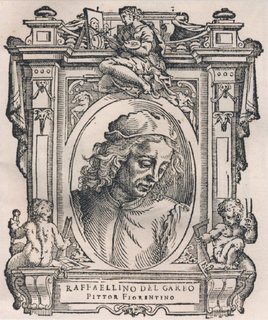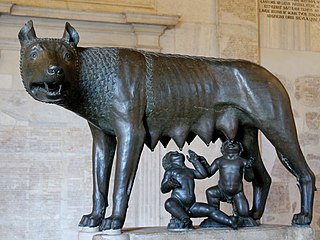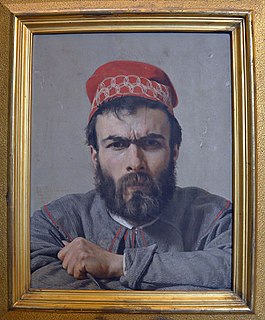Related Research Articles

Leon Battista Alberti was an Italian Renaissance humanist author, artist, architect, poet, priest, linguist, philosopher and cryptographer; he epitomised the Renaissance Man.

Donato di Niccolò di Betto Bardi, better known as Donatello, was an Italian sculptor of the Renaissance. Born in Florence, he studied classical sculpture and used this to develop a complete Renaissance style in sculpture, whose periods in Rome, Padua and Siena introduced to other parts of Italy a long and productive career. He worked with stone, bronze, wood, clay, stucco and wax, and had several assistants, with four perhaps being a typical number. Though his best-known works were mostly statues in the round, he developed a new, very shallow, type of bas-relief for small works, and a good deal of his output was larger architectural reliefs.

Bartolommeo Bandinelli, actually Bartolommeo Brandini, was a Renaissance Italian sculptor, draughtsman and painter.

The Arch of Titus is a 1st-century AD honorific arch, located on the Via Sacra, Rome, just to the south-east of the Roman Forum. It was constructed in c. 81 AD by the Emperor Domitian shortly after the death of his older brother Titus to commemorate Titus's official deification or consecratio and the victory of Titus together with their father, Vespasian, over the Jewish rebellion in Judaea. The arch contains panels depicting the triumphal procession celebrated in 71 AD after the Roman victory culminating in the fall of Jerusalem, and provides one of the few contemporary depictions of artifacts of Herod's Temple. It became a symbol of the Jewish diaspora, and the menorah depicted on the arch served as the model for the menorah used as the emblem of the state of Israel.

The Circus Flaminius was a large, circular area in ancient Rome, located in the southern end of the Campus Martius near the Tiber River. It contained a small race-track used for obscure games, and various other buildings and monuments. It was "built", or sectioned off, by Gaius Flaminius in 221 BC. After Augustus divided the city into 14 administrative regions, the Circus Flaminius gave its name to Region IX, which encompassed the Circus and all of the Campus Martius west of the Via Lata.

Raffaellino del Garbo was a Florentine painter of the early Renaissance.

The Basilica of St. Mary of the Altar of Heaven is a titular basilica in Rome, located on the highest summit of the Campidoglio. It is still the designated Church of the city council of Rome, which uses the ancient title of Senatus Populusque Romanus. The present Cardinal Priest of the Titulus Sanctae Mariae de Aracoeli is Salvatore De Giorgi.

As the home of the Pope and the Catholic curia, as well as the locus of many sites and relics of veneration related to apostles, saints and Christian martyrs, Rome had long been a destination for pilgrims. The Via Francigena was an ancient pilgrim route between England and Rome. It was customary to end the pilgrimage with a visit to the tombs of Sts Peter and Paul. Periodically, some were moved to travel to Rome for the spiritual benefits accrued during a Jubilee. These indulgences sometimes required a visit to a specific church or churches. Pilgrims need not visit each church.

The Temple of Antoninus and Faustina is an ancient Roman temple in Rome, which was later converted into a Roman Catholic church, the Chiesa di San Lorenzo in Miranda or simply "San Lorenzo in Miranda". It is located in the Forum Romanum, on the Via Sacra, opposite the Regia.

Boy with Thorn, also called Fedele (Fedelino) or Spinario, is a Greco-Roman Hellenistic bronze sculpture of a boy withdrawing a thorn from the sole of his foot, now in the Palazzo dei Conservatori, Rome. There is a Roman marble version of this subject from the Medici collections in a corridor of the Uffizi Gallery, Florence.

The Capitoline Wolf is a bronze sculpture depicting a scene from the legend of the founding of Rome. The sculpture shows a she-wolf suckling the mythical twin founders of Rome, Romulus and Remus. According to the legend, when King Numitor, grandfather of the twins, was overthrown by his brother Amulius in Alba Longa, the usurper ordered them to be cast into the Tiber River. They were rescued by a she-wolf that cared for them until a herdsman, Faustulus, found and raised them.

The Arch of Augustus was the triumphal arch of Augustus, located in the Roman Forum. It spanned the Via Sacra, between the Temple of Castor and Pollux and the Temple of Caesar, near the Temple of Vesta, closing off the eastern end of the Forum. It can be regarded as the first permanent three-bayed arch ever built in Rome.

Matteo Orsini was an Italian Dominican friar and Cardinal.
Giacomo Mazzocchi, in Latin on his titlepages Jacobus Mazochius, was a learned bookseller, printer, and noted antiquarian in papal Rome during the High Renaissance. A native of Bergamo, Mazzocchi is first heard of in 1505 as provider of finance for an edition of Vibius Sequester De fluminibus printed by J. Besicken of Rome. By 1509 Mazzocchi was himself in business as a printer. For humanists he might publish such scholarly works as the first printed repertory of Roman inscriptions, Epigrammata Antiquae Urbis, a folio of some 3,000 inscriptions, mostly of epitaphs, in which his collaborator was the Florentine priest Francesco Albertini This work includes inscriptions ranging from Roman Republican times to the age of Justinian I and is illustrated with somewhat stylised woodcuts showing some of the buildings and monuments of Rome, such as the Pantheon, the Arch of Constantine and the Pyramid of Cestius.
De mirabilibus urbis Romae, preserved in a single manuscript in Cambridge, England, is a medieval guide in Latin to the splendours of Rome, which was written in the mid-twelfth century by a certain Magister Gregorius of Oxford. The outlook here is even more secular than the Mirabilia Urbis Romae, Roberto Weiss noted. Gregorius spent much of his time describing and even measuring the Roman ruins, and, according to Erwin Panofsky "had yielded so thoroughly to the 'magic spell' of a beautiful Venus statue that he felt compelled to visit it time and again in spite of its considerable distance from his lodgings". Magister Gregorius is the first to take notice of the Roman bronze called the "Spinario", then among ancient bronzes at the Lateran. Panofsky included Magister Gregorius's little book among examples of the reawakening of interest in classical antiquities evinced by a handful of connoisseurs in twelfth-century Rome. Still, like most of his contemporaries raised in familiarity with the Gothic hand, the unfamiliar Roman letters in inscriptions sometimes eluded his translation.
Parastaseis syntomoi chronikai is an eighth- to ninth-century Byzantine text that concentrates on brief commentary connected to the topography of Constantinople and its monuments, notably its Classical Greek sculpture, for which it has been mined by art historians.

This timeline lists important events relevant to the life of the Italian diplomat, writer and political philosopher Niccolnardo dei Machiavelli (1469–1527).

The topography of ancient Rome is a multidisciplinary field of study that draws on archaeology, epigraphy, cartography and philology.

Giuliano Cesarini the Younger (1466–1510) was an Italian Roman Catholic cardinal.

Raffaello Sorbi was a 19th-20th century Florentine painter, specializing in narrative painting.